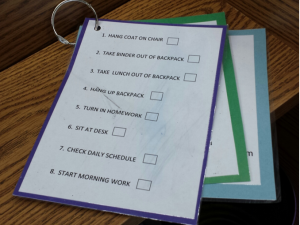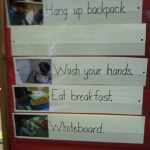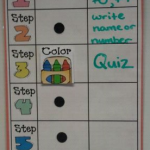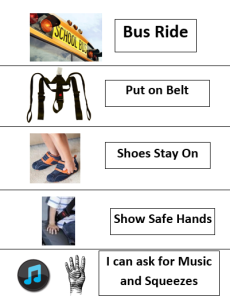If you are getting stuck on which points of the day to really focus on first with independence, look for the common routines. Look for events that take place everyday, at the same time, and have a very similar order to them. This can be a morning entry, getting lunch, math warm-ups, really anything that happens predictably.
 Instead of having to talk the student through the steps in each activity every day, you can begin to empower them to be more independent by putting those steps down in words or in pictures. As the student enters the task each day you can then refer them to their list and not your language. If done consistently the student often will no longer need you for help, and if done long enough the student often will no longer need the visual cue.
Instead of having to talk the student through the steps in each activity every day, you can begin to empower them to be more independent by putting those steps down in words or in pictures. As the student enters the task each day you can then refer them to their list and not your language. If done consistently the student often will no longer need you for help, and if done long enough the student often will no longer need the visual cue.
 Truthfully this is a best practice for all teachers, not just special educators. Here is a morning routine list I saw in a Kindergarten class a few years back. The children were greeted at the door by their wonderful teacher who referenced the first step and no more words were needed. Just below from a first grade class, a tool that was used many times throughout the day in which the required steps were displayed for all to see. What I like about both of these is
Truthfully this is a best practice for all teachers, not just special educators. Here is a morning routine list I saw in a Kindergarten class a few years back. The children were greeted at the door by their wonderful teacher who referenced the first step and no more words were needed. Just below from a first grade class, a tool that was used many times throughout the day in which the required steps were displayed for all to see. What I like about both of these is that it promotes the routines in a simple manner, but it also provides a way for steps to be switched up if need be. While its important for learners to be able to follow routines, when they are ready it is just as important for them to know what to do when those events are not routine.
that it promotes the routines in a simple manner, but it also provides a way for steps to be switched up if need be. While its important for learners to be able to follow routines, when they are ready it is just as important for them to know what to do when those events are not routine.
 For your more impacted learner you will want to look at even smaller events such as how to walk into the classroom, how to wash your hands, how to open the locker, or how to clean your desk To the right is a “check-in” routine I made for a student who needed such visuals everyday when they were greeted on the bus. By routinely being walked through this, it was only a matter of time before he could tell the routine to us as he got on.
For your more impacted learner you will want to look at even smaller events such as how to walk into the classroom, how to wash your hands, how to open the locker, or how to clean your desk To the right is a “check-in” routine I made for a student who needed such visuals everyday when they were greeted on the bus. By routinely being walked through this, it was only a matter of time before he could tell the routine to us as he got on.
Providing this sort of structure in a day should be used in conjunction with previously discussed behavior expectations and visual schedules, and doing so can have a dramatic effect on the rest of the learner’s day. Because when a student begins to feel good in their ability to perform independently in even the smallest of moments, their comfort and confidence in the schoolhouse can raise dramatically. Help your learners perform routines independently, and you will be promoting independence routinely.





